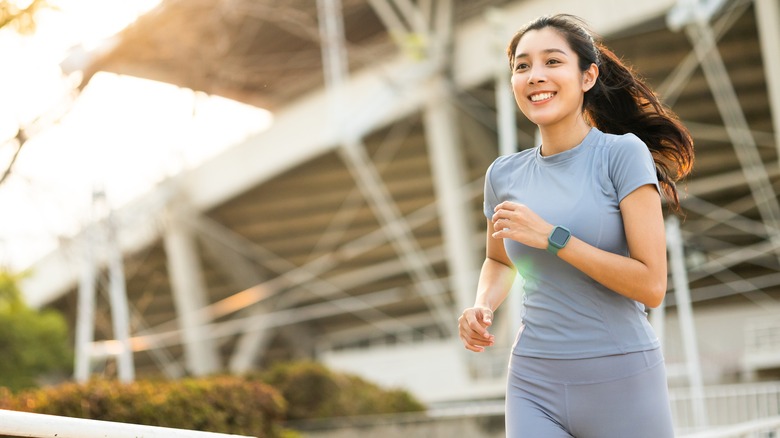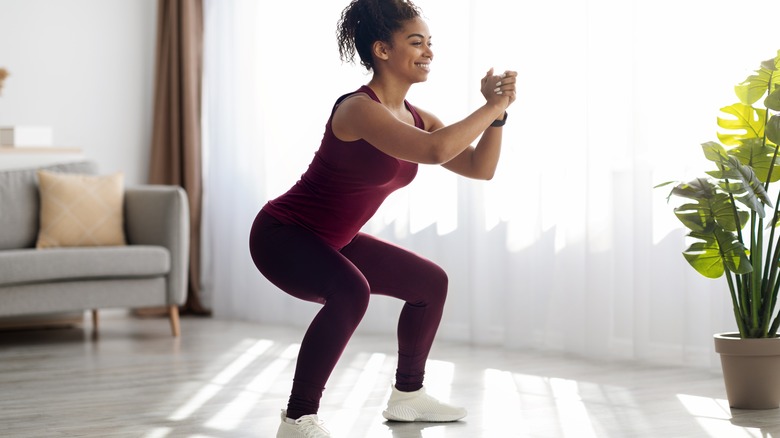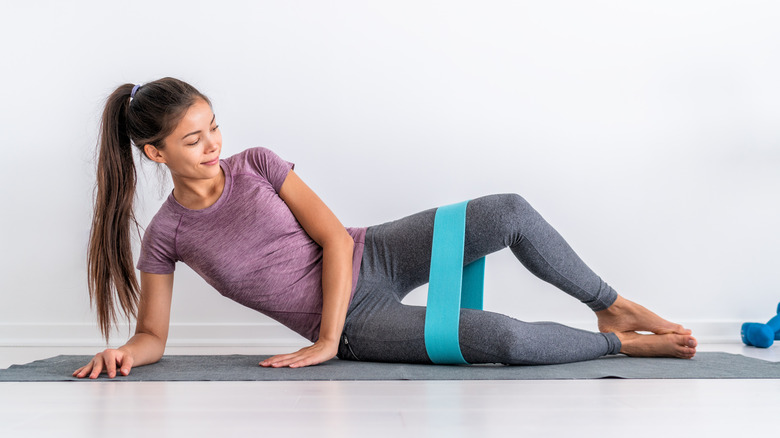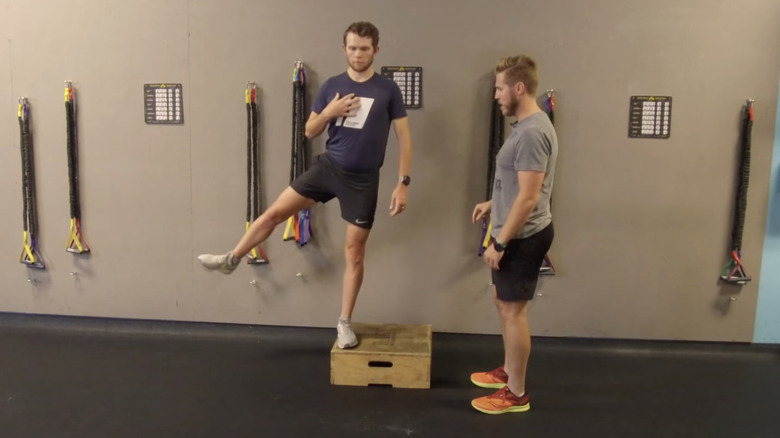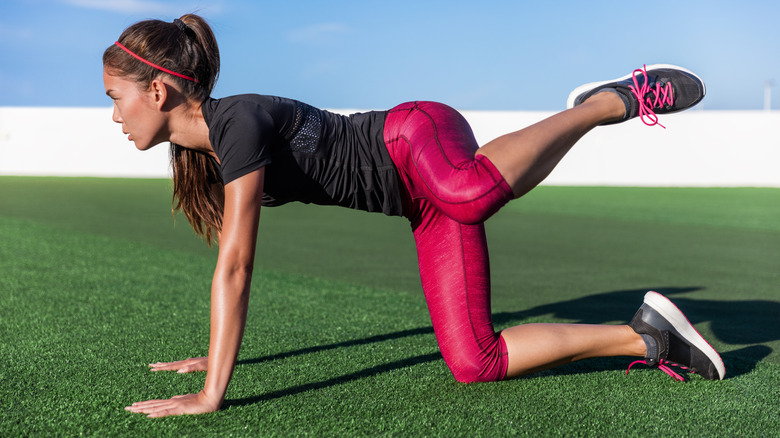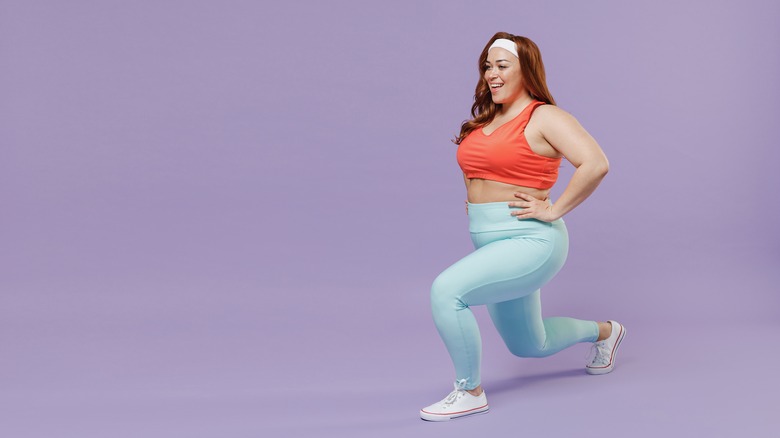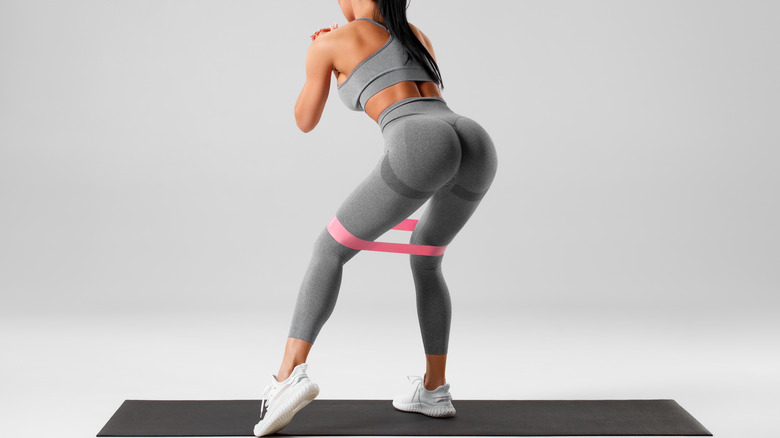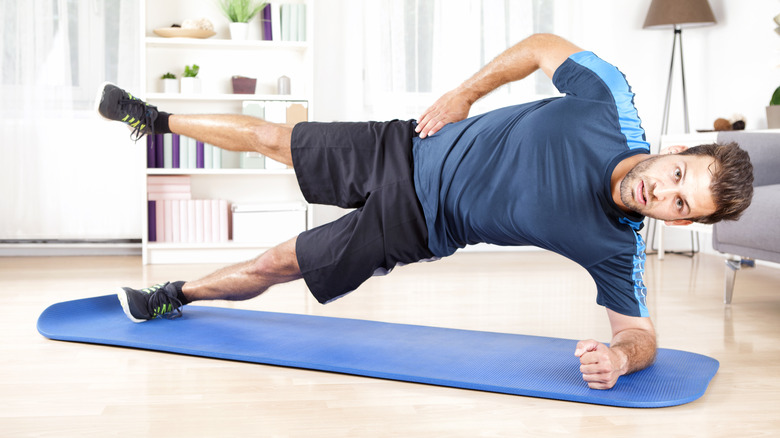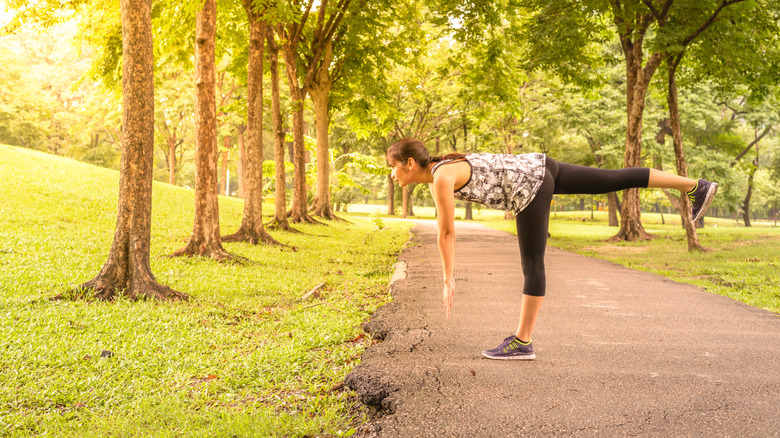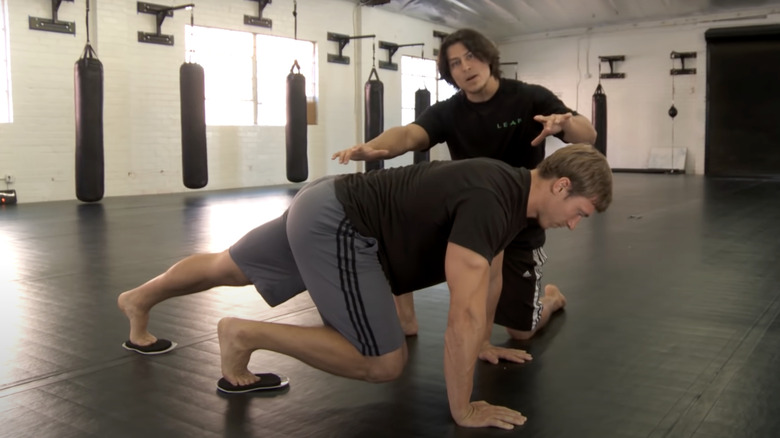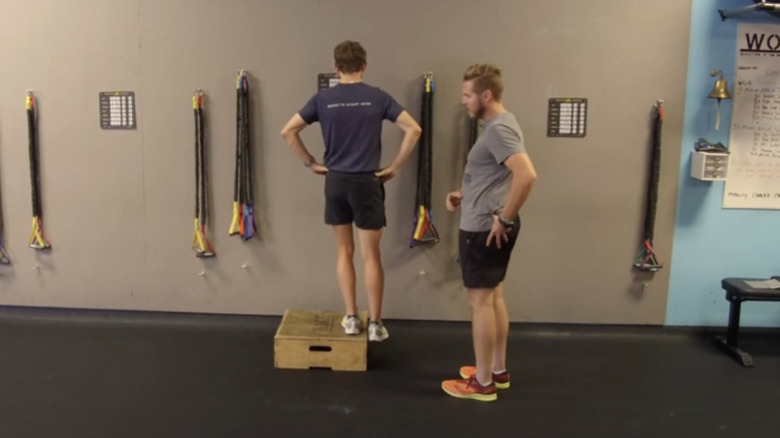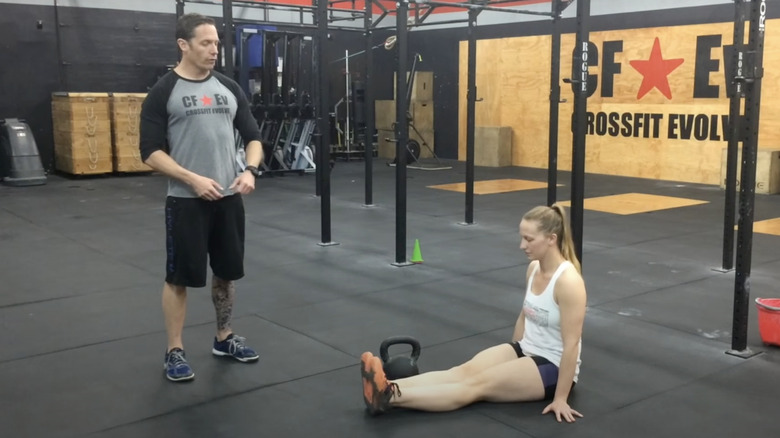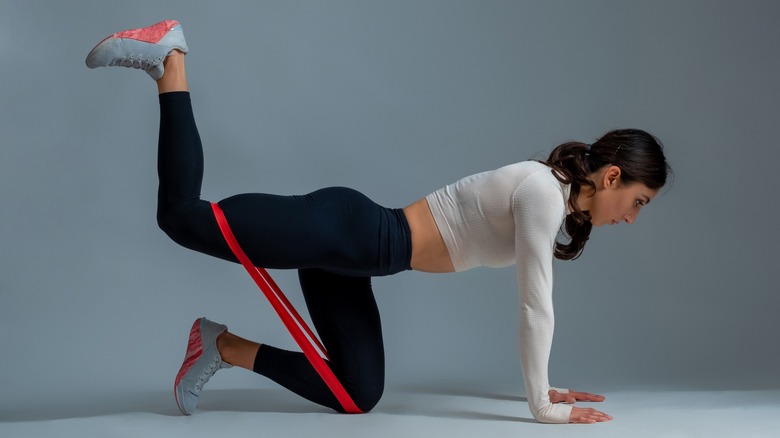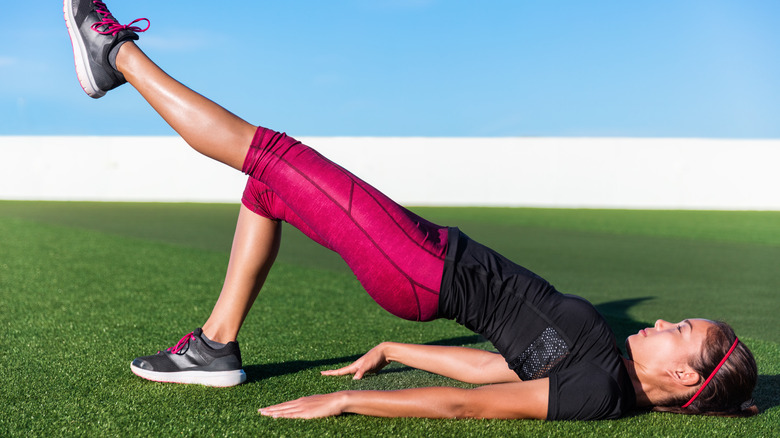Hip Exercises All Runners Should Add To Their Routine
The phrase, "It's all in the hips" doesn't just apply to Adam Sandler's golfing technique. It could easily be used when talking about running too. The hips, which are made up of the hip flexors and abductors, as well as your glutes, are one of the most important aspects of every step you take when you run. The hip muscles provide stability to your thighs and the rest of your leg, and drive your lower body forward, explains John Sauer, doctor of physical therapy (via SELF). As you might expect, though, the relentless involvement of the hips when running can mean that they're prone to imbalances and injuries, with research published in Current Reviews in Musculoskeletal Medicine estimating that there may be more than 1 million hip injuries among runners in the United States each year.
So, how do you correct hip imbalances and keep the area strong, to avoid compromising your jogging routine? The solution could be as simple as a few easy exercises. Incorporating hip exercises alongside a running regimen can help to keep all of the muscles in your hip region strong and flexible, and allow you to run pain-free for years to come. Let's take a look at some of our top exercise picks for those all-important hips of yours!
Squats
The squat is the king of lower body exercise moves, and while many love to hate them, there's no denying their advantages. In one single move, squats help to strengthen your lower back and knees, explains Medical News Today, as well as your hips, hamstrings, glutes, and quads (per Runner's World). "These are the biggest and most important muscles for runners because they power your stride," says Jason Fitzgerald, Strength Running creator. And powerful hips provided by squats not only decrease your likelihood of injury but can also improve your stride.
To perform a basic squat, you'll need to begin by standing upright, with your feet slightly wider than your hips. Your toes should be angled out slightly, to provide balance during the move. Place your hands on your hips or hold them in front of your chest. Then, start to lower your body by allowing your hips to move backward and your knees to bend. Continue moving in a downward direction until your thighs are level with the floor, or even further if you can, ensuring that your chest doesn't collapse and stays open. Pause briefly at the bottom, and then drive through your heels to return to standing, for a single rep. If you want even more challenge, you can try holding weights, to increase resistance.
Clamshell
Your glutes play a vital role in your overall hip strength and stability, and finding ways to work them out that don't rely on endless squat variations will keep your workouts interesting. That's why we recommend throwing a few sets of clamshells into your strength routine, a supremely useful move for runners thanks to their ability to not only strengthen your glutes but limber your muscles before your jog (per Coach Magazine).
Grab an exercise mat, and lie on one side, propped up on one elbow. Your upper arm should be directly below your shoulder joint, with your other arm placed in front of you or on your hip for stability. Bend your legs slightly, so your knees shift out in front of you, keeping your feet connected. From here, raise the upper leg, allowing your knee to move toward the sky without separating your feet. Activate your abs as you do so, to keep your body stable. At the highest point (which will be the point just before your hips have to rotate to accommodate), pause, and then lower your knee back to the other. Repeat for your desired amount of reps, and then switch sides. Adding a resistance band around your thighs or knees can be a great way to amp up this move even further.
Hip abduction exercise
Your hip abductors, which run along the outside of your hips and include gluteal muscles and the tensor fasciae latae (per Healthline), are heavily involved when you run. Hip abductors provide stability to your thighs as you land, explains Training Peaks, but unfortunately, they can commonly be weaker than we need them to be. This can lead to compensation from other muscles and an increased likelihood of strain or injury.
By throwing some hip abduction exercises into your repertoire, though, you'll keep those abductors strong. To do these, you'll need a small box or a step to stand on. Place yourself on the elevated surface, standing up straight, and shift your weight so that one of your feet is off the edge, while balancing on the other one with a slight bend in the knee (make sure whatever you're standing on is not too elevated, as you run the risk of injury if you lose balance). Then, raise the outer leg gently, moving on a horizontal plane, with your leg swinging out to the side. Keep raising your leg until it's as far as it can go without strain or pain, pause at the top, and then return it to your starting position. Perform 8 reps, and then rest before repeating, for a total of 3 sets on each side.
Hip CARs
To ensure that you're getting the best stride length you can, as well as the most comfortable run possible, you'll need mobility in your hips. And controlled articular rotations (or CARs) are one of the best ways to do this. Working on a circular plane of motion, hip CARs help to limber up the hip joint, while simultaneously improving your glute strength and benefitting your balance (per Straight Up Spine & Posture).
Unroll your exercise mat, and get onto all fours, with your limbs stacked neatly under your joints and your back long (per Runner's World). Keeping your abs engaged, lift one of your knees off the ground, and swing your thigh out to the side of your body. From here, start to rotate your leg backward from the hip joint, coming around to a "donkey kick" position and then returning your leg to its starting position on the floor. Repeat the rotation, doing as many as you can in 30 seconds, before planting that leg back and repeating the motion with the other leg. If so inclined, you can then repeat the CARs in the opposite direction with each leg.
Runner's lunges
If you want to make your running game stronger, pushing yourself on the track isn't the only way to do it. Strengthening the muscles you use during running can also add power and speed to your personal bests. And one of the best ways to do it is with strength moves that emulate running motion, like runner's lunges. "They not only improve running mechanics, but they strengthen your hip flexors, quads, and glutes, and improve mobility and stability throughout your lower-body joints," says BJ Gaddour, fitness director for Men's Health (via Men's Health).
To do a runner's lunge, begin by standing on the edge of an exercise mat, with the full length of it behind you, and some space in front. Your feet should be roughly shoulder-width apart. Lift one of your legs up and back, and take a step backward, planting your foot behind you and sinking into a lunge. Allow the arm on the same side to come forward, to work as a counterbalance for your front knee, which should be at a 90-degree angle. Pause here, and then step your leg back up and through, bringing your knee to your chest. If you can, continue the stepping motion back and forth without allowing your leg to return to a standing position as you work through your reps.
Banded side steps
Glute exercises typically rely on an up-and-down motion to work your butt muscles, but working on a sideways plane can reap some serious rewards too. And with banded side steps, the act of simply stepping side-to-side is amped up a notch with a resistance band, to create real strength in your glutes that will benefit your runs.
Stand on the end of an exercise mat, feet hip-width apart and your body facing sideways, and wrap a resistance band around the outside of your ankles (per Pop Sugar). The strength of your resistance band will depend on your leg strength and preference for your workout, but we'd recommend you start low and build up. Place your hands in front of your chest or on your hips, and come down into a semi-squat. Then, take a step to the side and along the length of your mat, with your other foot following to meet it. Continue this motion until you've side-stepped your way to the other end of your exercise mat, before stepping the other way. Try not to move up and down too much as you do this, and keep your hips facing the same direction the whole time. Keep stepping back and forth for up to a minute before resting and repeating.
Side planks with leg abduction
We're huge fans of working multiple muscle groups in one move, and side planks with leg abductions do just that. With a side plank, you're working your core and oblique muscles, and the added leg abduction action will help to strengthen your gluteus medius muscles, according to SELF. Working on both of these areas will keep your body stable while you run, and stop you from shifting from side to side too much, explains performance enhancement specialist Ali Kotek.
To begin, you'll first need to move into a stable side plank. Lie on one side on an exercise mat, with your body long, your lower arm underneath your shoulder joint, and your forearm placed flat on the mat to stabilize you. Engage your core, and push your body up into a side plank position, balancing on the side of your lower foot. Making sure that your body's in a straight line, lift your upper leg away from your body, scissoring your legs upward without turning your hips. You should feel the activation through your outer hip. Pause at the top, and then return your leg to the other before repeating the motion. Try and do this move for 15 reps maximum before repeating it on the other side, adding a resistance band around your thighs or calves for a further boost to your workout.
Single-leg deadlifts
Deadlifts aren't just for bodybuilders, people! With their ability to work the glutes effectively, these moves are a runner's best friend, and opting for a single-leg deadlift will also challenge and improve your balance and your hip stability, explains Kinetic Revolution. Additionally, single-leg deadlifts are also brilliant for your hamstrings, ankles, and core, which are all perpetually in use while you're out for a run.
You can perform a single-leg deadlift with just your body weight, or by using a dumbbell, kettlebell, or medicine ball. Stand up straight, with your feet a natural distance apart, with your weight held in your hands in front of you, if using one. Ensure that your knees are gently bent. Transfer your weight onto one leg, and lift the other leg behind you, ensuring that your back remains straight and your chest is open. Gently hinge at the hips, allowing your upper body to move forward and down, as your raised leg moves simultaneously up and back. If using a weight, it should drop forward and down with your body. At the bottom of the movement, you should achieve a near-horizontal line with your upper body and back leg. Pause briefly, and then working through the glutes and driving through the heel, return your body to a standing position. Repeat for up to 15 reps, for 3 sets, before working on the other leg.
Floor slider mountain climbers
Your hip flexors are constantly at work while you're running, but they can also be a bit of a problem area for athletes, especially those who spend their days sitting at desks. The strongest hip flexor muscle, the iliopsoas, gets shorter the more time you're sitting down. "The shorter that muscle, the shorter your stride becomes — and that throws off your natural gait, which can create compensations that lead to injury," explains Tom Holland, exercise physiologist (via Runner's World). That's why combatting this through exercises that elongate and strengthen your hip flexors is not only a good idea for their ability to help drive you forward, but also to avoid any injuries down the line.
Floor slider mountain climbers are a great way to train the hip flexors while improving your core strength too. Begin in a high plank position, with your body propped up on your hands, and your torso and lower body in a straight line, according to Medical News Today. Put a floor slider under the front of each foot (if you don't have sliders, you can use a substitute like a paper plate). Then, contract your abs, and slide one of your feet up and into your body, allowing your knee to come into your chest. Slide the foot back to the starting position, and then repeat with the other foot. Repeat for as many reps as you can handle.
Heel drop hip hikes
This move has more going for it than just being satisfying to say out loud (honestly, try it out, you'll see what we mean). Heel drop hip hikes can be particularly beneficial for individuals who have trouble with their iliotibial (or IT) band, tissues that run from your hips to your thigh (per WebMD). Heel drop hip hikes are especially good at working your hip abductors, supporting your IT band and adjacent muscles, and keeping your hips level while running (via Training Peaks).
Begin by standing on a low box or a step, and balance yourself on one leg, the other leg hovering off the edge. Place your hands on your hips for support, and then gently lower your hovering leg down, so that your hips tilt slightly and your foot becomes lower than the balancing one. Then, lift your leg back up from the hip (it should feel as though you're doing a sort-of sassy wiggle with your butt), and hike it up so that this time, it's slightly higher than the other side. Repeat the movement for 8 reps before resting and switching sides, completing 3 sets on each side in total.
Seated leg lifts
Given that when you're running, your body is constantly shifting weight from one side to another, so it's useful to practice exercises that try and emulate this motion and resemble "the way in which our bodies work while running," says Yusuf Jeffers, NASM-certified personal trainer (per Runner's World). Seated leg lifts are a great way to do this, working the hips from side to side while also activating the abs.
Grab an exercise mat, and sit down on it with your legs in front of you. Take your water bottle (or an object that's about a similar height), and put it next to one of your legs. With your hands placed gently in your lap or on your hips, take that leg, and lift it up and over the bottle, tapping your heel down on the other side. Then, lift the leg back over, and tap it down next to your other foot. Do this motion back and forth for roughly 30 seconds, and then rest, before moving the water bottle to the other side and repeating the exercise with the other leg. A more advanced move is to lift both legs at the same time and move them back and forth over the water bottle or whatever you've placed next to you.
Single-leg squats
Squatting is a great exercise for runners, but single-leg squats take it to a completely different level. "Running is nothing more than pushing off one leg at a time while maintaining balance," says Janet Hamilton, certified strength and conditioning specialist, and the single-leg squat allows you to build strength in your legs one at a time to complement your running action (per Runner's World).
Begin by standing as you would before a regular squat, with your feet hip-width apart or slightly wider, and your hands on your hips or clasped in front of you, explains SELF. Lift one of your feet off the ground, holding it a few inches in front of your body, and then send your hips back and squat down on your planted leg. Try and squat down as low as you can go, or place a chair or exercise bench behind you, and squat until you're sitting down in it. Pause briefly at the bottom of your movement, and then drive through your heel to push your body back up to standing. Resist the temptation, if possible, to put your elevated foot back on the ground before going into another squat. Perform between 10-15 reps, before switching legs.
Quadruped hip extension with resistance band
There are many moves that promise an unparalleled glute workout, but few exercises blast your booty as much as the quadruped hip extension with a resistance band. Wrapping the resistance band around your thighs creates additional exertion that your glutes will love, and your running performance will thank you for.
Begin by getting into all fours on an exercise mat, with your limbs stacked neatly under your joints, and place a resistance band around your thighs, explains Men's Health. "Be sure to use the knee of the non-working leg to trap the miniband to the ground. Then position the other side of the band just above the knee of the working leg," advises Bret Contreras, certified strength and conditioning specialist. Then, lift your working leg up and behind you, keeping your knee at a 90-degree angle, until the sole of your foot is pointing toward the ceiling. Turn your toe out slightly as you raise your leg, as this can work the glute and hip muscles even more. Return your leg to the ground, and repeat for between 20-30 reps, before working the other leg. Try and do three sets on each side.
Single-leg glute bridges
You didn't really think we'd write an article about hip exercises without including a glute bridge, did you? Glute bridges are arguably the true MVP of glute exercises, and by lifting one of your legs off the ground and working one glute at a time, you're able to build even more strength, benefitting your running regimen.
Grab your exercise mat, and lie on your back, with your knees bent and your feet flat on the floor, explains Runner's World. Place each hand palm-down next to your butt, to help support you during the exercise. From here, lift one of your lower legs off the floor and extend it in front of you, ensuring that your knees remain level with each other. Push your body up from the ground using your planted leg, activating your glutes as you do so until your upper body is in a straight line with your hips. Pause at the top of the movement, and then lower your body back to the ground, before repeating. Continue doing the glute bridges for around 30 seconds, and then switch legs, and repeat for the other side.

